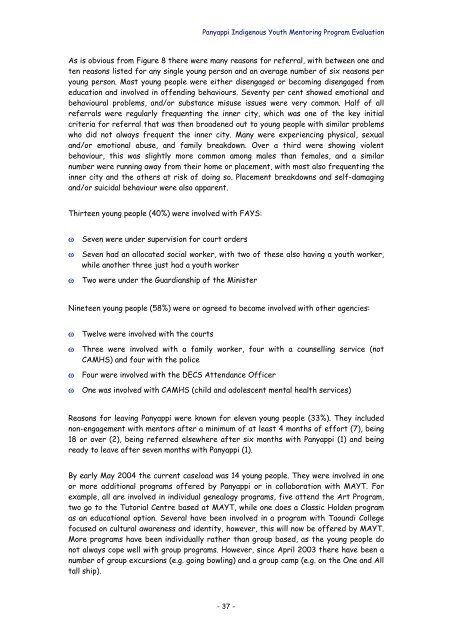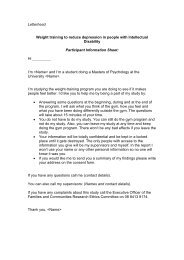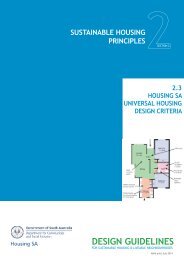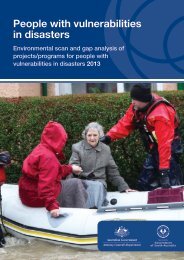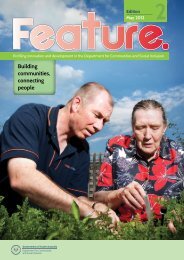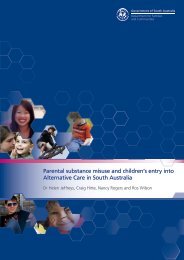Panyappi Indigenous Youth Mentoring Program Evaluation
Panyappi Indigenous Youth Mentoring Program Evaluation
Panyappi Indigenous Youth Mentoring Program Evaluation
Create successful ePaper yourself
Turn your PDF publications into a flip-book with our unique Google optimized e-Paper software.
<strong>Panyappi</strong> <strong>Indigenous</strong> <strong>Youth</strong> <strong>Mentoring</strong> <strong>Program</strong> <strong>Evaluation</strong><br />
As is obvious from Figure 8 there were many reasons for referral, with between one and<br />
ten reasons listed for any single young person and an average number of six reasons per<br />
young person. Most young people were either disengaged or becoming disengaged from<br />
education and involved in offending behaviours. Seventy per cent showed emotional and<br />
behavioural problems, and/or substance misuse issues were very common. Half of all<br />
referrals were regularly frequenting the inner city, which was one of the key initial<br />
criteria for referral that was then broadened out to young people with similar problems<br />
who did not always frequent the inner city. Many were experiencing physical, sexual<br />
and/or emotional abuse, and family breakdown. Over a third were showing violent<br />
behaviour, this was slightly more common among males than females, and a similar<br />
number were running away from their home or placement, with most also frequenting the<br />
inner city and the others at risk of doing so. Placement breakdowns and self-damaging<br />
and/or suicidal behaviour were also apparent.<br />
Thirteen young people (40%) were involved with FAYS:<br />
ω<br />
ω<br />
ω<br />
ω<br />
ω<br />
ω<br />
ω<br />
Seven were under supervision for court orders<br />
Seven had an allocated social worker, with two of these also having a youth worker,<br />
while another three just had a youth worker<br />
Two were under the Guardianship of the Minister<br />
Nineteen young people (58%) were or agreed to became involved with other agencies:<br />
Twelve were involved with the courts<br />
Three were involved with a family worker, four with a counselling service (not<br />
CAMHS) and four with the police<br />
Four were involved with the DECS Attendance Officer<br />
One was involved with CAMHS (child and adolescent mental health services)<br />
Reasons for leaving <strong>Panyappi</strong> were known for eleven young people (33%). They included<br />
non-engagement with mentors after a minimum of at least 4 months of effort (7), being<br />
18 or over (2), being referred elsewhere after six months with <strong>Panyappi</strong> (1) and being<br />
ready to leave after seven months with <strong>Panyappi</strong> (1).<br />
By early May 2004 the current caseload was 14 young people. They were involved in one<br />
or more additional programs offered by <strong>Panyappi</strong> or in collaboration with MAYT. For<br />
example, all are involved in individual genealogy programs, five attend the Art <strong>Program</strong>,<br />
two go to the Tutorial Centre based at MAYT, while one does a Classic Holden program<br />
as an educational option. Several have been involved in a program with Taoundi College<br />
focused on cultural awareness and identity, however, this will now be offered by MAYT.<br />
More programs have been individually rather than group based, as the young people do<br />
not always cope well with group programs. However, since April 2003 there have been a<br />
number of group excursions (e.g. going bowling) and a group camp (e.g. on the One and All<br />
tall ship).<br />
- 37 -


